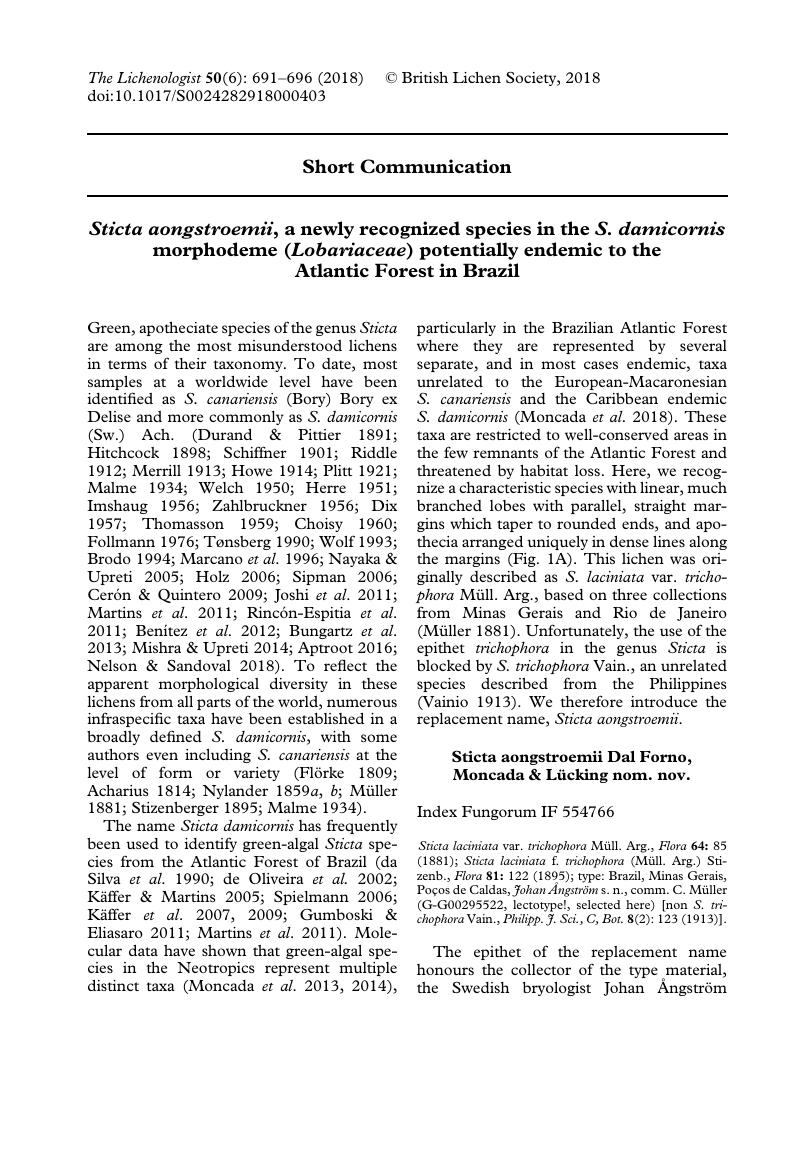Crossref Citations
This article has been cited by the following publications. This list is generated based on data provided by Crossref.
de Menezes, Aline Anjos
da Silva Cáceres, Marcela Eugenia
Bastos, Cid José Passos
and
Lücking, Robert
2018.
The latitudinal diversity gradient of epiphytic lichens in the Brazilian Atlantic Forest: does Rapoport's rule apply?.
The Bryologist,
Vol. 121,
Issue. 4,
p.
480.
Mercado‐Díaz, Joel A.
Lücking, Robert
Moncada, Bibiana
Widhelm, Todd J.
and
Lumbsch, H. Thorsten
2020.
Elucidating species richness in lichen fungi: The genusSticta(Ascomycota: Peltigeraceae) in Puerto Rico.
TAXON,
Vol. 69,
Issue. 5,
p.
851.
Moncada, Bibiana
Mercado-Díaz, Joel A.
Smith, Clifford W.
Bungartz, Frank
Sérusiaux, Emmanuël
Lumbsch, H. Thorsten
and
Lücking, Robert
2021.
Two new common, previously unrecognized species in the Sticta weigelii morphodeme (Ascomycota: Peltigeraceae).
Willdenowia,
Vol. 51,
Issue. 1,
Torres, Jean-Marc
Barbosa, Thiago D.
Kitaura, Marcos J.
Spielmann, Adriano A.
and
Lorenz, Aline P.
2021.
Two new species of Sticta (Peltigeraceae subfam. Lobarioideae) from the Brazilian Cerrado (Brazilian savanna).
The Bryologist,
Vol. 124,
Issue. 4,
Ossowska, Emilia Anna
Moncada, Bibiana
Kukwa, Martin
Flakus, Adam
Rodriguez-Flakus, Pamela
Olszewska, Sandra
and
Lücking, Robert
2022.
New species of Sticta (lichenised Ascomycota, lobarioid Peltigeraceae) from Bolivia suggest a high level of endemism in the Central Andes.
MycoKeys,
Vol. 92,
Issue. ,
p.
131.
Kukwa, Martin
Rodriguez-Flakus, Pamela
Aptroot, André
and
Flakus, Adam
2023.
Two new species of Astrothelium from Sud Yungas in Bolivia and the first discovery of vegetative propagules in the family Trypetheliaceae (lichen-forming Dothideomycetes, Ascomycota).
MycoKeys,
Vol. 95,
Issue. ,
p.
83.
Ossowska, Emilia Anna
Moncada, Bibiana
Lücking, Robert
Flakus, Adam
Rodriguez-Flakus, Pamela
Olszewska, Sandra
and
Kukwa, Martin
2024.
Additional new species and new records of the genus Sticta (lichenised Ascomycota, lobarioid Peltigeraceae) from Bolivia.
MycoKeys,
Vol. 105,
Issue. ,
p.
21.
Di Meglio, Joseph R.
Niedbala, Jack C.
and
Di Meglio, Elisa B.
2024.
Sticta puebloensis (Lichenized Ascomycota: Peltigeraceae) a New species of Sticta from the American Southwest.
Plant and Fungal Systematics,
Vol. 69,
Issue. 2,
p.
195.
Ossowska, Emilia Anna
Schiefelbein, Ulf
and
Kukwa, Martin
2024.
First records of Sticta arenosella and S. cellulosa from South America based on molecular and morphological data.
Plant and Fungal Systematics,
Vol. 69,
Issue. 1,
p.
77.
Ossowska, Emilia Anna
Moncada, Bibiana
Lücking, Robert
Sérusiaux, Emmanuel
and
Magain, Nicolas
2025.
Sticta flakusiorum and S. kukwae—two additional new species from the Neotropics (Peltigerales, Peltigeraceae).
MycoKeys,
Vol. 114,
Issue. ,
p.
259.



